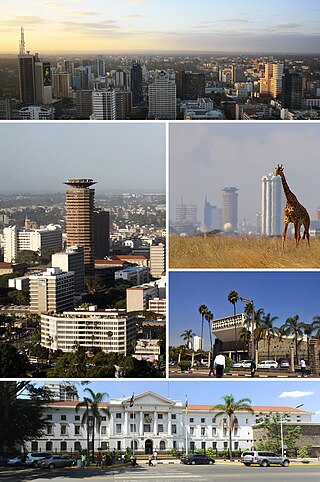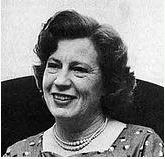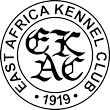
Nairobi is the capital and largest city of Kenya. The name is derived from the Maasai phrase Enkare Nairobi, which translates to 'place of cool waters', a reference to the Nairobi River which flows through the city. The city proper had a population of 4,397,073 in the 2019 census. The city is commonly referred to as The Green City in the Sun.

Nakuru is a city in the Rift Valley region of Kenya. It is the capital of Nakuru County, and is the third largest urban area in Kenya. As of 2019, Nakuru has an urban population of 570,674, making it the largest urban centre in the Rift Valley, succeeding Eldoret, Uasin Gishu County. The city lies along the Nairobi–Nakuru Highway, 160 kilometres (99 mi) from Nairobi.

Rugby union in Kenya is a popular sport, in particular due to the success of the Kenya national rugby sevens team in the rugby sevens format, and tournaments such as the Safari Sevens, which has been growing yearly, and now includes numerous international teams.
Madatally Manji was a Kenyan industrialist and entrepreneur, best known for founding the House of Manji, a food manufacturing company.

The predominant religion in Kenya is Christianity, which is adhered to by an estimated 85.5% of the total population. Islam is the second largest religion in Kenya, practised by 10.9 percent of Kenyans. Other faiths practised in Kenya are Baháʼí, Buddhism, Hinduism and traditional religions.

Indians in Kenya, often known as Kenyan Asians, are citizens and residents of Kenya with ancestral roots in the Indian subcontinent. Significant Indian migration to modern-day Kenya began following the creation of the British East Africa Protectorate in 1895, which had strong infrastructure links with Bombay in British India. Indians in Kenya predominantly live in the major urban areas of Nairobi and Mombasa, with a minority living in rural areas.
Fahamu is a not-for-profit organization supporting organizations and social movements championing progressive social change and human rights. With branches in the United Kingdom, South Africa, Senegal, and Kenya, Fahamu primarily engages with civil and human rights organizations through Pambazuka News, an online platform focusing on social justice. Additionally, they offer online courses on human rights and social justice and employ new technologies, including SMS, for information dissemination, lobbying, and interactions.

Established in 1950, the East Africa rugby union team is a multi-national rugby union team drawing players from Kenya, Uganda and Tanzania, though the vast majority of these came from Kenya which has traditionally been the strongest rugby playing nation in the region. The team has played against incoming international, representative and club touring sides and it conducted seven tours between 1954 and 1982.

Alibhai Mulla Jeevanjee was an Indian-born Kenyan merchant, politician and philanthropist. He was amongst the first and most influential Indian settlers in Kenya, amassing significant wealth and becoming a leader of Kenya's Indian community.
The following is a timeline of the history of the city of Nairobi, Kenya.
Firoze Madatally Manji is a Kenyan activist with more than 40 years’ experience in international development, health, human rights, teaching, publishing and political organizing.
Hafeez Manji is a former Kenyan cricketer whose single list-A appearance for the Kenyan national side came in October 2003, when he was aged 15.

Eugenie Dorothy Hughes, was a Kenyan architect, politician, social reformer and disability activist. She founded the Kenyan Council of Social Services and served as the head of the Sports Association for the Disabled. As the first East African female architect, she owned her own firm and is best known for her design of the Cathedral of the Holy Family in Nairobi.
The House of Dawda Group is a privately owned conglomerate in Uganda.
Manilal Ambalal Desai was an Indian born activist and journalist who played a prominent role in Kenyan politics during the 1920s.
Isher Dass was an Indian born member of the Legislative Council of Kenya between 1933 and his death in 1942. He was the first member of the Legislative Council to be assassinated.
Mohamed Ismail Shams-ud-Deen was an Indian born member of the Legislative Council of Kenya between 1922 and 1946.
Anwarali Versi, professionally known as Anver Versi, is a Kenyan-born journalist who is editor-in-chief of New African magazine, based in London. He began his journalistic career in Nairobi, before moving to England, where he eventually worked for several UK-based pan-African publications, including African Business and African Banker. Other newspapers and journals for which he has written include The Times, The Independent, The Wall Street Journal, the Chicago Tribune and the International Herald Tribune.

The East Africa Kennel Club is the official kennel club of the East African countries of Kenya, Uganda, Tanzania, Rwanda and Burundi.
The Luo Union was a welfare organisation formed in Nairobi, Kenya, in the early 1920s. This organisation sought to create, expand and govern a general cultural identity among Luo people in East Africa. Luo people are a Nilotic ethnic group native to western Kenya and the Mara Region of northern Tanzania in East Africa. The Luo Union was one of several welfare organisations started during the colonial period in East Africa which aimed at building broad cultural unity. This organisation played a crucial role in creating a collective sense of identity and unity amongst Luo people after the Second World War. It was also an important medium of grassroots political support for African Nationalist movements in the 1950s. The Luo Union FC was the unions soccer club. This club would later become Gor Mahia FC, one of Kenya's best performing football clubs.









